Coffee pull: a course on detailed skills of milking update video teaching in July 2016
Several factors affecting coffee flower counting
Factor I: Concentration
[Powder amount]
It plays the role of timpani drum in the whole concentrated extraction. Where does the concentrated solution come from without dry powder, and how much dry powder determines the flavor trend of your concentrated solution. The amount of powder can be 5g or 30g, eclectic. But we usually fall between 18-20g.
No matter how many techniques you have in the future, the first step is to determine the amount of powder. With that in mind, the rest was simple:
How much coffee do you want?
[Extraction Time]
Espresso golden rule of extraction time is specified in 22~28 seconds, but extraction time is actually a comprehensive performance of filling pressure, powder and grinding degree, need to rely on the barista's understanding of Espresso to adjust.
[Extraction Volume]
Espresso single 30 ml, double 60 ml extraction volume almost no one will change, except for a few Italians will use a single coffee powder volume but only extract 15 ml coffee solution.
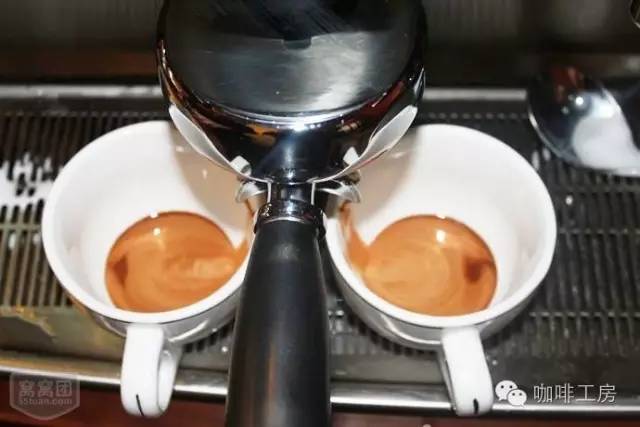
The selection of the amount of extraction powder, coffee powder doubles, your extraction solution doubles, as long as the ratio between powder and solution is the same, usually at 1:2, the flavor of the coffee will be close.
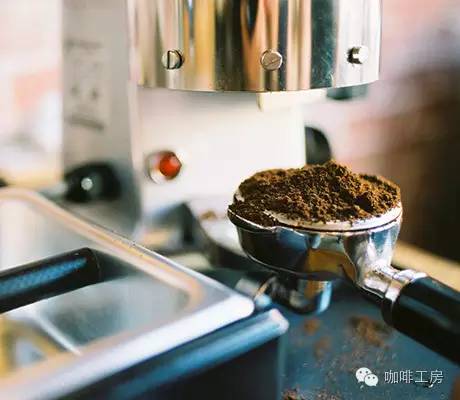
Factor two: milk foam
Foaming finished milk should be dense and delicate with a sense of luster. If the thickness of the foam is different, it will not be able to draw a contrasting pattern, nor can it be well integrated with espresso, which will eventually affect the overall taste.
Make milk bubbles:
① first opens the steam nozzle once to remove the residual water vapor from the nozzle.
② inserts the steam nozzle deep into the milk in the flower cup and turns on the steam. When the steam is ejected, slowly move the nozzle up to a shallower position in the milk to increase contact with air.
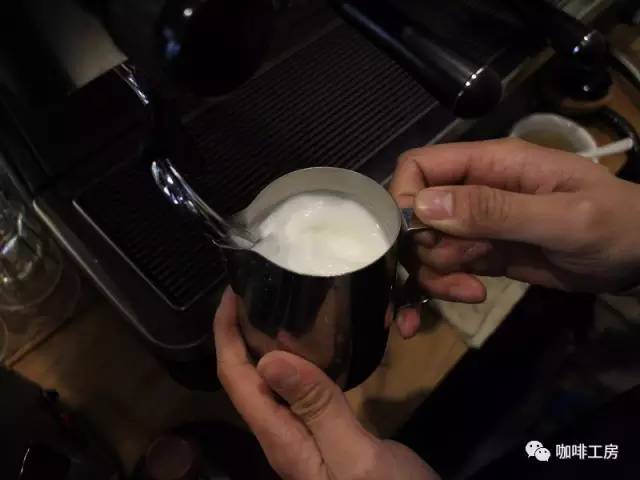
When the ③ is almost complete, push the nozzle deeper down again to adjust the overall fine density of the foam.
After ④ foaming is finished, tap the bottom of the cup on the table a few times, or pour it into another jar to remove the larger bubbles. Then gently shake the flower cup around the circle to make the overall texture of the foam uniform.

When the ③ is almost complete, push the nozzle deeper down again to adjust the overall fine density of the foam.
After ④ foaming is finished, tap the bottom of the cup on the table a few times, or pour it into another jar to remove the larger bubbles. Then gently shake the flower cup around the circle to make the overall texture of the foam uniform.
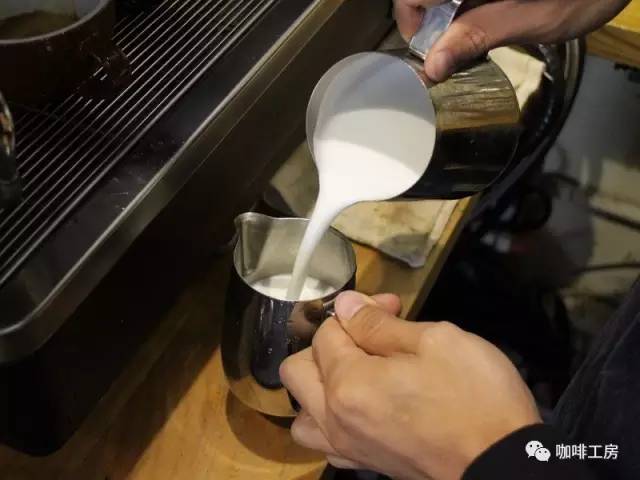
Factor three: integration and tactics
Cup height: refers to the distance between the milk jar and the coffee cup
The distance between the normal milk jar and the coffee cup is about 5ml 10cm (reference). To be exact, it should be the distance between the cylinder mouth and the coffee liquid surface. Each Lafayette is different at this point, and there is no exactly the same height and distance. There is no fixed height.
But the purpose is only one point, that is, to fully integrate the milk foam with the coffee. Because the density of the milk foam is small and light, we often choose to increase the distance between the milk tank and the coffee liquid surface to avoid destroying the cleanliness and color of the oil. So we have to understand that the thicker the bubble, the higher the distance (impact), on the contrary, the thinner the bubble, the lower the distance.
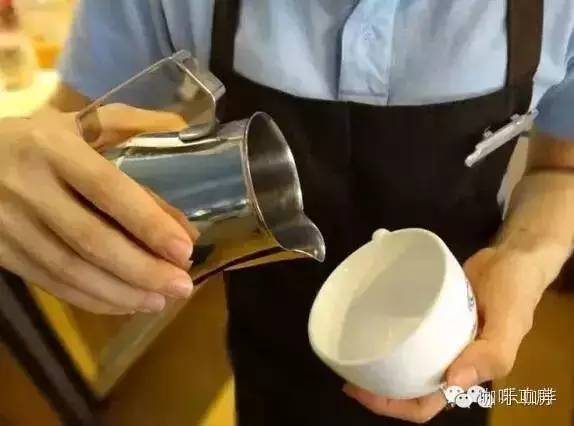
2, milk flow size: refers to the thickness of milk flow when the milk in the milk jar is poured into the coffee cup
The normal reference value is: the milk flow is a little thinner under constant conditions, and the purpose of the milk flow size is to ensure that the milk foam and coffee are fully integrated without destroying the cleanliness and color of the oil.
If the milk flow is too thick, it will have a greater impact, and there will be a certain chance of turbulence at the bottom of the cup, so we will generally choose a finer milk flow for fusion. If it is more flexible, the size of the milk flow should be carried out in line with the quality of the milk bubbles. For example, if the milk foam is too thick, we need a higher distance and a finer milk flow. On the contrary, when the milk foam is thinner, we can choose the micro-coarse milk flow and the closer milk flow to merge.

3. Fusion techniques: fusion techniques can be roughly divided into three types: one-word fusion, circle fusion and fixed-point fusion.
These techniques do not have a great impact on the fluidity of flower drawing: let's start with the differences between the three methods.
The one-word fusion method is the de-fusion of swinging left and right on a line, which greatly reduces the area of damaged oil and achieves the purpose of fusion.
The circle fusion method is the circle de-fusion method, which moves on the grease surface to a large extent to achieve the purpose of fusion.
The fixed-point fusion rule is to carry out fusion at a point, which hardly destroys the surface cleanliness of grease and achieves the purpose of fusion.
The three fusion methods have their own advantages and disadvantages. In terms of fusion state and uniformity, the best effect must be circle fusion (that is, large area de-fusion). The reason is very simple. The larger the fusion area, the easier it is to fully integrate milk foam and coffee. Fixed-point fusion and one-word fusion requires super grease and very good milk foam. Therefore, it is recommended to circle a large area to merge.
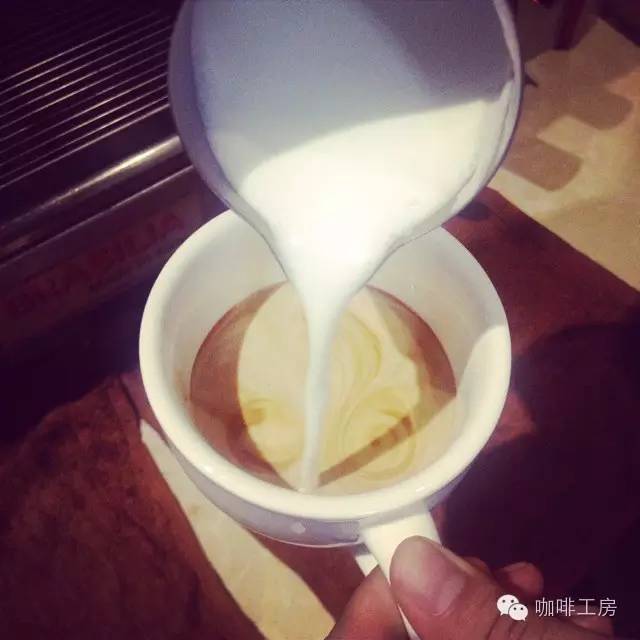
4. Fusion quantity: refers to how much milk foam is fused into the cup, and how much fusion liquid is mainly affected by the fluidity of the liquid surface when pulling flowers (the following examples assume that fat, milk foam and fusion methods are consistent).
The process of fusion is actually the process of pouring milk foam into Espresso:
The amount of fusion liquid = the amount of milk foam poured = the fluidity intensity of the liquid surface;
Fusion liquid less (that is, poured into the milk bubble less), the liquid surface contains less bubbles resistance is also small, so high fluidity;
Fusion liquid more (that is, poured into the milk bubble more), the liquid surface contains more bubbles than the resistance is large, so the fluidity is low;
So the amount of fusion liquid is different, the fluidity of the liquid surface is also different.

[flower drawing]:
Leaves | Coffee flower drawing core skills and essentials (slow motion analysis)
Dedicated to flower lovers, embossed tulips illustration steps [with video teaching]
The steps and skills of a swan
A thousand layers of heart | the strongest 520 confession in history!
[rose blossom] Coffee flower drawing, basic skills and pattern shaping
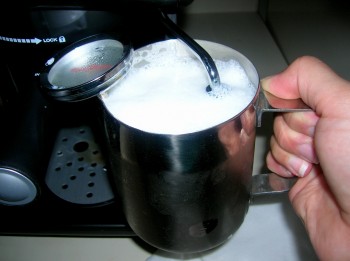
If I understand this question correctly, I can classify cappuccino into three categories according to the quality of milk foam, one is wet cappuccino, one is dry cappuccino, and the other is half cappuccino in between. So how do we distinguish between these three kinds of cappuccino? If the foam technology passes, you can use the quality of the foam to distinguish as follows: premise: 600ml (medium) pull the flower jar around, and fill the milk at the bottom of the nozzle. First, the wet cappuccino milk foam is 6 or 7% full; (this milk bubble to do leaves and other lines require more pattern is very good-looking, at the same time, this milk foam can also be used to do latte). Second, the dry cappuccino milk foam is full. Third, the half cappuccino milk foam is 80% full; I prefer 90% milk foam. This foam is great for heart, apple and tulip patterns. In fact, what we usually use most is this kind of milk foam, which is used to make the cappuccino that is common in our daily work.
Tip: practice now. I want to hit a jar full of 70% milk foam, never 90% full. Let's do it!
Five misunderstandings of milking
For milk foam, there are several misunderstandings that we need to understand, so that we can better understand milk foam.
The first misunderstanding: the use of shaking up and down to pull the vat to remove the rough foam on the surface. This is a very good method, but many friends have a strong dependence on this method, their own milk foam did not play well, do not summarize why they did not play well, but use this means to make up for it. In the long run, there will be dependence. Here I must say that if we only rely on this way to get rid of the coarse foam, there is no way to improve the foam technology, nor can we practice the advanced skills of pulling flowers.
The second misunderstanding: scoop off the coarse foam with a spoon. This method is what I reject most. Although some contestants use some methods in the competition, I think this is because their milk foam technology does not pass, the surface is too thick to shake off, can only scoop. For those who use similar methods to deal with milk bubbles, be sure to strengthen your steam control technology in milk foam.
The third misunderstanding: after beating up the foam, put it aside for a while. This method is very annoying, which is a form of expression that the milk foam technology has not been introduced yet. This will aggravate the layering of milk bubbles, and the integration of hot milk and foam will not be easy to complete. if you don't pay attention to it, it will become milk and foam. The whole cup of coffee doesn't balance the taste.
The fourth misunderstanding: the two jars will fall in a very high position, the original purpose is to merge, but to arouse more coarse bubbles.
The fifth misunderstanding: the milk foam is not good, blame the steam. The author believes that the steam pressure of the coffee machine (that is, boiler pressure) is relatively easy to grasp in 0.8BAR, this pressure is very long, and it is easy to understand the principle of milk foaming, but it takes about 13 seconds to make a cup of milk foam, ah, not as fast as the pressure. If the air pressure is 1. 0 or 1.1BAR, the way and method of bubbling will change, but the principle is the same. (at this point, it is necessary to rule out the phenomenon of "vomiting" caused by impure steam, and the flower jar is also shaking violently. If this happens, please empty the steam and try to heat it fully again.)
VI. common problems and treatment methods of milking
1. Can the milk from the manual milking machine be used to pull flowers?
The answer is yes. Let's first look at the simple deconstruction of espresso. Espresso has two basic features, that is, the upper layer is a layer of coffee-like foam, and the bottom is black coffee liquid. This kind of coffee can be used to make lace coffee. So all we have to do is to fill the coffee cup with black coffee about 30ml, then use the beaten milk foam, pour in a little bit, and then stir it well with a spoon, and the white milk foam on the surface becomes a "coffee-colored foam", and it floats on top of the black coffee. Next, we can use milk foam to pull flowers, I have tried N times, ah, the effect is good. However, the coffee made with this kind of liquid is too light, and the flowers with strong layers have limitations, so we can only try it and do not promote it. Of course, it's good to practice your hands in this way from time to time.
two。 Why is the milk foam not fused?
As soon as the milk foam is poured into the concentrate, it is immediately mixed with the coffee, and it is impossible to float on it like the milk foam in the master pull flower video. I don't have enough foam and don't mix enough with milk, and I sometimes do the same.
3. How can I mix the milk well?
Is the milk and milk foam, how to mix it well, pull flowers, a pour is not all white? Temperature. Temperature is important. When you foam, put your empty hand on the flower cup to feel the temperature of the milk. When you feel very hot and can no longer be placed on the flower jar, it will make the foam too hard. The hard foam looks stiff, and it doesn't mix with the coffee when you pour it into the coffee, but accumulates on top of your coffee like fluffy beaten cream. If you play a little longer, it will be layered, 90% of which is flowing milk, and a thick hard foam lid floating on it. When you pour it into the coffee, the milk will flow out of the flower cup first. So if you want to mix milk and foam well, temperature is the key. Do not put the foam for too long after playing, otherwise it will be stratified.
4. How to make more and meticulous milk foam?
On how to make a good milk bubble, here provides a stupid milk bubble method, that is, pour half of the milk into the steel cup, let the steam pipe and the milk perpendicular to the center or the edge of the steel cup, then let the steam head just touch the surface of the milk, then turn on the steam to 1pm 2, do not move the steel cup, slowly close when the milk reaches 50 degrees, close at 60 degrees, and finally the temperature will reach 66 degrees. In this way, you can make a good cup of foam.
5. What kind of Italian machine do you want to use for milking?
Generally speaking, there are steam heads with three, four and five holes in the machine, and as long as they are a little familiar with them, they all make good milk bubbles. However, the amount of steam produced by the machine, the degree of dryness and wetness of the steam, and the size of the stomata still have an impact on milking.
6. Why do you use water to practice milking?
First, as we all know, water is transparent, which allows you to see more clearly how the vortex is formed.
The second is to better master the number of holes in the play of different milk bubbles! Third, beginners should remember to use a thermometer when you fail to beat the milk foam into a thin shape, and the temperature cannot be better controlled, so the coffee you make is unstable. You may hit the milk foam once or twice out of ten times, but that is not a stable quality.
7. The difference between steam milking and manual milking
First of all, the hand-beaten foam cannot be compared with the steam of the machine at all. The fineness of the steam makes its milk foam very delicate and slippery, and the radiation surface of the steam is wide, so the milk foam will be more uniform and mix better. The hand is mainly squeezed through the small hole of the filter screen, and the milk foam is thicker.
8. How to use the electric milking machine bought at home to make milk foam?
I use my own local method to make milk foam, and it feels good. The appliance is the electric milk beater, 9.9RMB, which is bought by Yijia. Step: add fresh milk to the glass, heat it in the microwave oven for 45 seconds, stir in the milking machine for 1 minute, and the milk foam will become. I use a French press to filter out the 50ml coffee and pour it directly from the top of the foam. I can see that the coffee is gradually mixed with the milk and the white foam rises slowly.
9. How to make milk foam?
Method 1: use a milk bubble pot to make handmade milk foam
1. Pour the milk into the milk bubble pot, the amount should not exceed 1 stroke 2 of the milk bubble pot, otherwise the milk will overflow due to expansion when making the milk bubble.
two。 Heat the milk to about 60 degrees, but not more than 70 degrees, otherwise the protein structure in the milk will be destroyed. Be careful! The lid and strainer cannot be heated directly. (for example, make ice foam to cool the milk below 5 degrees Celsius, of course, do not overfreeze and let the milk freeze.)
3. Put the lid and the filter on, and quickly twitch the filter to press the air into the milk. when you twitch, you don't need to press to the end, because you want to pump the air into the milk, so you can act on the surface of the milk; you don't need too many times. gently twitch about 30 times.
4. Remove the lid and strainer and scrape off the thick foam with a spoon, leaving dense hot (ice) foam.
Method 2: use steam foam to make milk foam.
Do not put the steam pipe into the milk, because there may be some condensed water in the steam pipe, so let off some steam in the front section and drain the excess water by the way.
Insert the thermometer into the container, then insert the steam pipe obliquely into the milk and turn on the steam switch.
Slowly adjust the position of the steam nozzle to a little bit from the surface of the milk, but never above the liquid level, or the milk will be spilled everywhere. A steady "hiss" will be heard when it is in the right position, otherwise it will be very loud or almost silent.
When the milk foam is sufficient, you can bury the steam pipe a little deeper and let the steam continue to heat the milk. The angle of the steam pipe had better be just enough to make the milk rotate.
The steam switch can be turned off when the diffuse reaches between 60 and 70 degrees.
Wipe the milk attached to the steam pipe with a wet dishcloth and release another steam at the same time to prevent the milk from being difficult to clean after it is dry.
7. Netizens' experience in milking
1. An easy-to-use method of foam for beginners
Put the cold meal milk into about half a flower cup; spray off the remaining water from the steam pipe; insert the milk at an angle of 30-40 degrees, the insertion position is at the center left 1x4 (or right); turn on the steam, first rotate the milk fully, slowly move the flower cup down, do not let the steam nozzle away from the milk too much (easy to produce coarse bubbles) When you feel warm (or when you think the milk foam is sufficient), the steam is inserted deeper into the milk again, so that the whirlpool appears obviously on the surface, and uses the whirlpool to get involved in the coarse bubbles; when you feel slightly hot, turn off the steam, draw out the steam pipe, spray out the remaining milk, wipe the milk stains on the steam head, and return the steam head to position. The above play is whirlpool milk, first look at, and then hit the cotton play. Suitable for beginners.
two。 The secret of making milk foam
ESPRESSO machine steam pipe foam some experience, to share with you. Milk should be taken out of the refrigerator and poured into a steel cup, which can feel the temperature and is easy to control; after the steam pipe is opened, wait for it to blow off the water vapor, and then put it shallowly a little under the surface of the milk, the angle should be tilted a little more, and the sound of steam can be heard; after the milk is gradually warmed up, adjust the angle similar to the angle that the steam is driving the whole glass of milk to rotate. After feeling a little hot, put the steam pipe deeper. When the cup is badly hot, turn off the steam and remove the steel cup immediately, otherwise the foam will disappear if it is overheated. Then keep the machine clean, turn on the steam, blow the residual milk out, and then scrub the milk traces on the outside of the steam pipe when cleaning the machine, so that you can make good foam. If you want the foam to be dense, the steam pipe should not be too deep. I have used all kinds of major milk in the market, all of which can be done, you can have a try. Fendy69: I hit it with a manual bubbler. Frozen milk can beat very well, delicate and dense, but the 60-degree one is not so good. When hand-foaming, the fat content of milk must reach 4% to 4.5% (high-fat milk) is better. The brand is not a big problem.
3. The skills of Green Wheat
The milk still needs to be heated, and ice should be used if you use the steam engine, because the steam will heat the milk. Beat the foam, shake twice on the table covered with a rag, let the big foam float, and use a spoon to scrape off the thick foam. Stir 2 times counterclockwise with a spoon to the bottom. When you pour, the spoon blocks the milk foam, and what goes down is the milk. When the coffee liquid surface is 2.5cm from the cup mouth, lift the spoon, gently dip from the bottom of the milk tank, the milk foam goes down, and cappuccino comes out in one fell swoop. (coffee uses espresso) the fragrance of coffee, the smoothness of milk, the delicate foam! No sugar is recommended.
The skills of 4.xy1234
Milk foaming condition, milk temperature is about 1ml 10 ℃, 600ml steel is packed with 1x3, first turn on the steam pipe switch, spray the excess steam to avoid diluting the milk, put the steam pipe deep into the stainless steel cup about 1cm, turn on the steam switch, listen to the sound change, rotate the stainless steel cup up and down, when the milk temperature reaches about 38 degrees Celsius. Put the steam pipe deep into the milk to stop foaming, make it rotate, and turn off the steam switch when the milk temperature reaches 60 degrees. After the milk is beaten, the temperature should not be too high. Shake evenly from 50 to 60 degrees. The temperature of the coffee should not be higher than 90 degrees. Only in this way can the quality of the flowers be guaranteed.
The skills of 5.minghao_jiang
My experience is that the temperature of milking should not be too high. Otherwise, the milk foam is very easy to break. If the good milk powder is poured into coffee or other drinks, it will automatically mix at the bottom and a layer will gradually float up. In this way, there will already be a thin layer of milk powder under the liquid surface of the cup after adding half of the milk powder. It will be easy to pull flowers on top. The overheated milk is poured down. This layer of milk is so thin that it can't even cover the whole cup. The milk starts to flow when you pull flowers. My experience is to stop when you feel a little hot.
Either iced milk or steamed milk is fine. Ice milk must be between 0 and 4 ℃ to make ice foam; milk milk must exceed 60 ℃ to make milk foam.
6. The process of making milk foam of Little Prince raymond777.
The nozzle that dispels the steam is attached to the edge of the coffee machine. The nozzle can be turned, but use it carefully, because the heated nozzle is very hot, especially after bubbling. After removing the nozzle, pour the iced milk (about 8 oz) into the milk pot, about half the size of the milk pot; let the nozzle spray steam before putting the nozzle into the milk pot. In this way, the spray pipe can be preheated and the water gathered by steam in the pipe can be washed away. At this point, extend the spray pipe into the milk surface of the milk pot, then open the steam control key half a circle, wait for the milk convection, and then turn the control key to the maximum. At first, it will make a "Zhi" sound. After 2 seconds on the surface, it can be put into the bottom, and then mentioned in the middle, until the foam rises to 90% of the milk bubble pot. (there are many ways to play foam. It can be played differently according to the air pressure of different machines, and the hand of the flower pot can be kept motionless when the air pressure is high). If you make a "sawing" sound and it is very harsh, it will be wrong, which proves that your method is wrong.
When making milk foam, it is important to note that the milk used must be frozen milk. As there are many kinds of milk brands on the market, I suggest you use Nestle's full-fat pure milk. The temperature of the milk should not exceed 65 oC, and the time should be between 8 and 15 seconds. The foam should be made in one fell swoop. The steam foam should be textured, neither rough but uneven foam nor soft, light foam. The ideal foam should be very tight, thick and smooth as a whole, and feel moderately heavy, just like peanut oil when poured out.
After using the steam, clean the nozzle and the sprinkler immediately, carefully wipe the milk on the sprinkler with a wet cloth, and then open the nozzle to let the steam spray the remaining milk in the sprinkler, so as to avoid blocking the sprinkler after the milk dries.
How to use the steam foam after drying?
In the milk bubble pot, the state of the foam that has just been steamed is: the upper layer is floating foam and the lower layer is hot milk. If you use it to pull flowers, be sure to shake the bubble pot clockwise so that the foam in the pot is combined with milk, and then scoop out the thicker foam on the surface, and then pour it out for use; if you make American coffee, wait about ten seconds, first let the foam completely float to the surface of the liquid, and then use a spoon. Extracting good coffee and getting rid of high-quality foam is what a professional barista must do and must be 100% aware of. The coffee is not extracted well, no matter how beautiful the coffee is and how good the foam is, this cup of coffee is just a cup of garbage. Appearance is important, but taste is more important, so students should keep in mind. Similarly, I hope the students will practice more and be an excellent barista.
The skills of 7.HalfCafe
This milk foam is really good (manual foam). In the supermarket bought 3 boxes of morning pure milk (green box), when to come back to try the effect of foam, just this morning power outage, boring, take it out to try, really good. A box of 250ML, poured out less than half, TIAMO double-layer milk beater, frozen milk directly beat, after more than 20 twitches up and down, feel resistance, continue to beat, do not know how many times, open to see the effect, very dense foam, the whole beater is almost full of dense foam, poured into the cup, can only see a little milk that can flow, there is no flowing milk, making lattes is a failure, it feels like cream or ice cream Ha ha, it's not finished yet, there's still leftover in the milking machine (the cup is small).
The problem of milk foam and flower drawing between Cabo and latte. Cabo:: the ratio of extra concentrated to hot milk to foam is 1:1:1, and the foam needs to be tight / thick. Latte:: extra concentrated & Hot Milk & the ratio of milk bubbles is 1:2:1, and the foam needs to be delicate and "flowing" relative to Cabo's. If my understanding is correct, it is that making kapos and lattes requires different textures of milk foam. Tight / thick foam is relatively difficult to make a beautiful flower directly, isn't it? Does that mean that the general latte is more suitable for drawing flowers directly, while Cabo is more suitable for drawing flowers?
My recipe (for reference only) is very strong: milk: the ratio of foam to milk, kabu 1v 1purl 1; latte 1:8:1.
It's hard to imagine ordering a CAPPUCCINO at Starbucks at this ratio. Take the 12-ounce tall cup as an example, that's 4 ounces of ESP, 4 ounces of milk, 4 ounces of foam. Oh, my God, 4 ounces of ESP is 4 portions of SINGLE ESP. That's a lot of concentration. What proportion to choose mainly depends on the positioning of your own store. If it is the same as the American-style coffee shop, then there is no need to attach so much importance to this proportion. If it is positioned as a traditional Italian coffee shop, you can only use a special caliper cup, strictly according to this proportion. Latte cups are usually in 240ml~360ml. Except for the space occupied by espeesso, the other cups are milk. When the foam is well beaten, the volume is twice as large as before.
A simple way to make milk foam
I used to use the steam stick and milk bubble pot on the electric Italian steam compressed coffee pot I bought in the past. When I looked at the TIAMO CD the other day, I found that it was stirred in the heated milk with that kind of small electric blender, so I took out the very simple electric blender bought from Ikea, which was used to beat eggs at home, and did not use a fat higher than 3. 5% milk, take an ordinary bag of milk, heat it in the microwave oven for 1 minute and 30 seconds, and then start stirring. Unexpectedly, the effect is good, the foam stops delicate, 242ml milk filled the 500ml glass beaker full, because full, so stop stirring. I am very satisfied with the cappuccino coffee. I feel that this method of milking is the simplest and most convenient, so you can try it.
Experience of beating milk foam manually
If the temperature of the milk is not high (about 60 degrees), the milk foam is thicker, but if it is heated to about 80 degrees, the milk foam is very smooth and fine. I would like to share my little experience with you.
Why are all the bubbles floating on the coffee? I beat Mengniu milk! It was hit by hand, and when it was poured in, it floated on the coffee! It's not what went wrong! The milk foam floating on the coffee noodles shows that your milk foam is too thick, that is, what we say is not enough cotton! Pull flowers need milk foam with high density and fine density. First of all, you have to make sure that the ESP with rich gold foam is used. If there is no gold foam, the ESP will float on the coffee surface as soon as the foam is poured in. It is useless to pull up the milk jar. In addition, you need to make sure that the quality of your milk cannon is qualified. This is my experience. The foam should float on it. Is it not fine enough for a tuo to float on it? Raise the milk tank and smash those coarse bubbles down, but try to beat the foam a little bit, hitting him is just a helpless move. Also just practice drawing flowers, a little humble opinion, I hope I can help you.
Explanation of machine steam pipe
First explain the difference between the two holes and the four holes: generally speaking, the steam rod of the old machine (coffee maker) of 02 years ago had two holes. When making milk foam, one hole only entered the inner layer of the milk. The other hole is exposed to send out the air so that the milk is swirled by the air, and the air enters to form milk bubbles. The other hole that only enters the inner layer of milk plays the role of heating! the coffee machine after 2002 is mostly four-hole, the same reason. However, it should be noted that there are three holes: heating, air entry, and the formation of whirlpool. Another hole, uh, is that the whirlpool formed by speeding up the dishing of milk bubbles can quickly form milk bubbles again.
How to draw flowers
Remember to use a thermometer when the milk temperature rises to 35 degrees Celsius. When the milk temperature rises to 40 degrees Celsius, it is the best time for foam to start. At the beginning of learning, put the flower pot against the edge of the cup until it goes down. Scrape off the top layer of the finished foam. Then shake the foam well, and here comes the key. Put the cup close to the cup, when you start to pour in, you must remember, ah, to flow, that is, do not make the grease covered by milk bubbles. When you pour to the sixth quartile of the cup, you will begin to enlarge the flow. At this time, you will see some milk bubbles appear on the surface and shake off. The fixed point big rush (from the beginning to the end is also the fixed point to pour) to receive a small flow, slowly forward. This is the basic style-heart, just when the foam is combined with the ES, make the horizontal line shake left and right in time (only when the fifth quartile) remember, set a point, don't go back, and reduce the flow rate forward when the cup is almost full. I suggest that you should first come into contact with the bar or use more tap water and a few pieces of ice to learn how to make a whirlpool, which requires patience. If the basic skills are solid enough to make coffee, of course. No, no, no. Of course, after learning to add ice with water, you can choose 1VR 0.5, for example: 100cc water + 50CC milk to save materials, and it is easier to master the scientific method of making coffee.
The most suitable foaming temperature for milk is 60 degrees Celsius. "this is limited to the practice of beating the foam by hand." after you have finished beating, you should scrape off the coarse foam at the top about 2 centimeters and move quickly. no, no, no. no, no, no. Shake the foam in a circle after scraping off, and the foam should be as thick and smooth as liquid cream. It will happen slowly, if the grease is not thick enough. Can be sprinkled with cocoa powder (other powder can also be used) instead. In the end, the best initiation period of milk foam is 35-40 degrees Celsius or 60 degrees Celsius, which needs to be mastered by yourself. according to the information I consult, we generally recommend 60-65 degrees Celsius. Explanation about milk: the fat content of whole milk is about 3%, low-fat milk (semi-skim milk) contains 1.0-1.5% fat, and whole skim milk contains 0.5% fat.
Why do you use water to practice drawing flowers?
1. As we all know, water is transparent, which allows you to see more clearly how the vortex is formed. two。 Can better master the number of holes in the play of different milk bubbles! 3. For beginners, remember to use a thermometer when you fail to beat the foam into a thin shape, and the temperature cannot be better controlled. Then the coffee you make is unstable. You may hit the foam once or twice out of ten times, but that is not a stable quality.
What kind of coffee beans do you choose for Italian concentrate?
Choose coffee beans, comprehensive beans, more than four varieties. Among them, robusta beans need to be added to improve the fat. Other beans are as you like.
How to clean in the bean grinder?
Need to use white granulated sugar, general household use, sell two yuan to clear the beans and powder in the bean grinder, start the bean grinder to slowly pour the sugar into the machine, until ground into powder. Then it is seen that the white granulated sugar turns black until the powdered sugar is no longer black. The last step is to remove the powdered sugar, and then start the bean grinder to pour in the beans until the powdered sugar is cleared. Then the solid powder stuck to the grinding plate will be cleared, and the bean grinder needs to be cleaned every day (at the close of the market), especially the grinding plate needs to be cleaned with a brush, and the powder bin also needs to be cleaned.
Important Notice :
前街咖啡 FrontStreet Coffee has moved to new addredd:
FrontStreet Coffee Address: 315,Donghua East Road,GuangZhou
Tel:020 38364473
- Prev
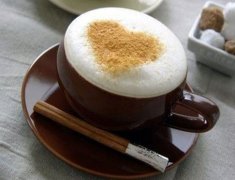
How to use the milking machine correctly
Many coffee lovers like to add milk from a manual milking machine to the pure Italian "ESPRESSO" coffee to pull flowers and make delicious and beautiful fancy coffee. If the home is equipped with a manual milking machine, first heat the milk and then use the manual milking machine to foam to make cappuccino, saving money, worry and effort.
- Next

When doing ESP, is the pressure on the powder bowl the same?
When doing ESP, is the pressure in the middle of the powder bowl the same as around it? There are slight differences that can be ignored.
Related
- What is the meaning of lactic acid fermentation with coffee bean treatment?
- How to judge the state of foam by sound?
- How does the latte pull out the unicorn pattern? Come to get for a little trick to improve the flower pull!
- Will flower pulling affect the taste of the latte?
- Do you know the history of coffee?
- The difference between honey treatment and sun washing what is raisin honey treatment?
- What kind of milk can a novice use to make coffee foam to keep the foam longer? The correct method and skills of milking tutorial sharing
- Why do washed coffee beans taste sour? Flavor characteristics of washed Coffee
- Introduction to the skill of how to practice the size and height of water injection around the circle of hand-brewed coffee
- How do beginners practice coffee flower drawing from scratch?

